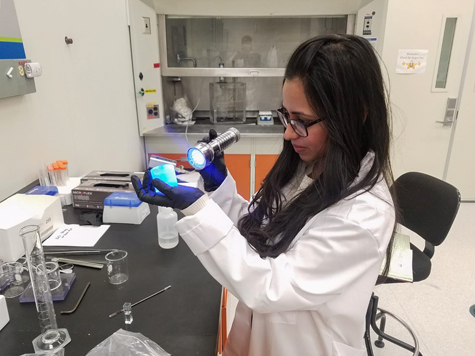Overcoming Engineering Problems in a Zinc-Sulfide Plastic Scintillator and Introducing a Quantum Dot Gel-Based Scintillator
Priyarshini Ghosh
Post-doctoral - Astrophysicist & Nuclear Engineer
The Catholic University of America
NASA Goddard Space Flight Center
Wed, September 27, 2023 - 4:00 PM
 Great detectors are born from great engineering, but I’d like to present to you an underdog and a newcomer scintillator. The underdog is ZnS, which was the first ever material to be used as a scintillator, but has since been relegated to use in thin films with low fast-neutron detection efficiency due to its opacity to its own fluorescence despite having a high light yield. The Micro-Layered Fast-Neutron Detector (MLFD) has been designed by way of geometric orientation to overcome this light opacity, and thereby boast a higher fast neutron detection efficiency. It is also inherently discriminant to gamma rays, thus not requiring pulse-shape discrimination (PSD) in environments containing both fast neutrons and gamma rays, where neutron detection is required exclusively. Originally built for accident-tolerance testing of nuclear reactor fuels, the MLFD can also be used in Special Nuclear Materials searches. The second detector, Scintillation Hydro-Gel for Isotopic Neutron Emitters (SHINE), introduces a newcomer to the field of scintillation: environmentally-friendly quantum dots (QD) in a gel-based shapeshifter matrix. The gel format incorporates benefits of both solid and liquid scintillators while avoiding their respective disadvantages, such as continuous filtering of contaminates, slow throughput of containers, and higher base component costs in liquid scintillators, and ‘dead’ voids associated in solid scintillators. SHINE uses InP/ZnS, an eco-friendly QD with a large Stokes shift to prevent self-absorption of light for thermal neutron detection. SHINE has been successfully tested and demonstrates promise as a replacement for current3He neutron detectors, and has potential use in hand-held, compact neutron detection units.
Great detectors are born from great engineering, but I’d like to present to you an underdog and a newcomer scintillator. The underdog is ZnS, which was the first ever material to be used as a scintillator, but has since been relegated to use in thin films with low fast-neutron detection efficiency due to its opacity to its own fluorescence despite having a high light yield. The Micro-Layered Fast-Neutron Detector (MLFD) has been designed by way of geometric orientation to overcome this light opacity, and thereby boast a higher fast neutron detection efficiency. It is also inherently discriminant to gamma rays, thus not requiring pulse-shape discrimination (PSD) in environments containing both fast neutrons and gamma rays, where neutron detection is required exclusively. Originally built for accident-tolerance testing of nuclear reactor fuels, the MLFD can also be used in Special Nuclear Materials searches. The second detector, Scintillation Hydro-Gel for Isotopic Neutron Emitters (SHINE), introduces a newcomer to the field of scintillation: environmentally-friendly quantum dots (QD) in a gel-based shapeshifter matrix. The gel format incorporates benefits of both solid and liquid scintillators while avoiding their respective disadvantages, such as continuous filtering of contaminates, slow throughput of containers, and higher base component costs in liquid scintillators, and ‘dead’ voids associated in solid scintillators. SHINE uses InP/ZnS, an eco-friendly QD with a large Stokes shift to prevent self-absorption of light for thermal neutron detection. SHINE has been successfully tested and demonstrates promise as a replacement for current3He neutron detectors, and has potential use in hand-held, compact neutron detection units.
Refreshments served at 3:45 PM
If you have any questions about the Colloquium Series or would like to make a donation please contact the Physics Department, cua-physics@cua.edu or (202) 319-5315.
